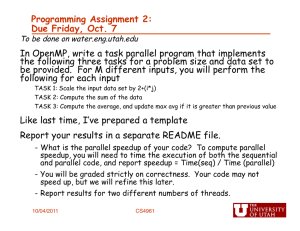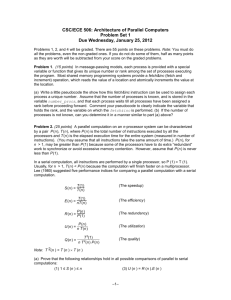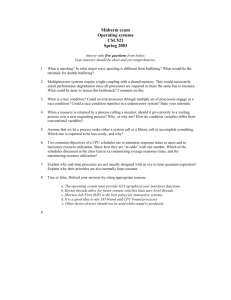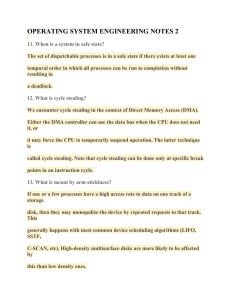Chapter5 Dr. Mohsen NASRI College of Computer and Information Sciences,
advertisement
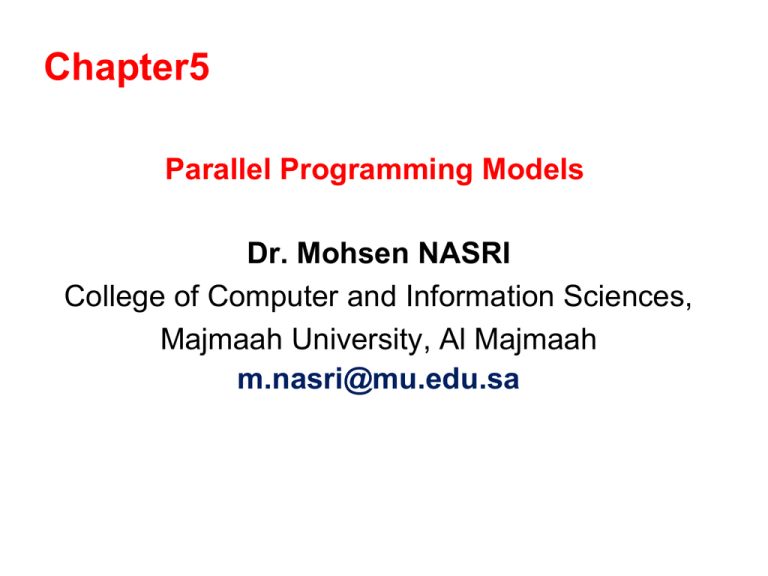
Chapter5 Parallel Programming Models Dr. Mohsen NASRI College of Computer and Information Sciences, Majmaah University, Al Majmaah m.nasri@mu.edu.sa • • • • • Shared Memory Model Threads Model Message Passing Model Data Parallel Model Other Models Shared Memory Model • In the shared-memory programming model, tasks share a common address space, which they read and write asynchronously. • Various mechanisms such as locks / semaphores may be used to control access to the shared memory. • An advantage of this model from the programmer's point of view is that the notion of data "ownership" is lacking, so there is no need to specify explicitly the communication of data between tasks. Program development can often be simplified. • An important disadvantage in terms of performance is that it becomes more difficult to understand and manage data locality. Shared Memory Model: Implementations • On shared memory platforms, the native compilers translate user program variables into actual memory addresses, which are global. • No common distributed memory platform implementations currently exist. Threads Model • • In the threads model of parallel programming, a single process can have multiple, concurrent execution paths. Perhaps the most simple analogy that can be used to describe threads is the concept of a single program that includes a number of subroutines: – – – – – – • The main program a.out is scheduled to run by the native operating system. a.out loads and acquires all of the necessary system and user resources to run. a.out performs some serial work, and then creates a number of tasks (threads) that can be scheduled and run by the operating system concurrently. Each thread has local data, but also, shares the entire resources of a.out. This saves the overhead associated with replicating a program's resources for each thread. Each thread also benefits from a global memory view because it shares the memory space of a.out. A thread's work may best be described as a subroutine within the main program. Any thread can execute any subroutine at the same time as other threads. Threads communicate with each other through global memory (updating address locations). This requires synchronization constructs to insure that more than one thread is not updating the same global address at any time. Threads can come and go, but a.out remains present to provide the necessary shared resources until the application has completed. Threads are commonly associated with shared memory architectures and operating systems. Threads Model: OpenMP • OpenMP – Compiler directive based; can use serial code – Jointly defined and endorsed by a group of major computer hardware and software vendors. The OpenMP Fortran API was released October 28, 1997. The C/C++ API was released in late 1998. – Portable / multi-platform, including Unix and Windows NT platforms – Available in C/C++ and Fortran implementations – Can be very easy and simple to use - provides for "incremental parallelism" • Microsoft has its own implementation for threads, which is not related to the UNIX POSIX standard or OpenMP. Message Passing Model • The message passing model demonstrates the following characteristics: – A set of tasks that use their own local memory during computation. Multiple tasks can reside on the same physical machine as well across an arbitrary number of machines. – Tasks exchange data through communications by sending and receiving messages. – Data transfer usually requires cooperative operations to be performed by each process. For example, a send operation must have a matching receive operation. Performance Metrics for Parallel Systems: Execution Time • Serial runtime of a program is the time elapsed between the beginning and the end of its execution on a sequential computer. • The parallel runtime is the time that elapses from the moment the first processor starts to the moment the last processor finishes execution. • We denote the serial runtime by parallel runtime by TP . and the Performance Metrics for Parallel Systems: Total Parallel Overhead • Let Tall be the total time collectively spent by all the processing elements. • TS is the serial time. • Observe that Tall - TS is then the total time spend by all processors combined in non-useful work. This is called the total overhead. • The total time collectively spent by all the processing elements Tall = p TP (p is the number of processors). • The overhead function (To) is therefore given by To = p TP - TS Speed-Up • Speedup: S(p) = Execution time on one CPU Execution on p processors Speedup is a measure of how well a program “scales” as you increase the number of processors. • We need more information to define speedup: • What problem size? • Do we use the same problem for all p’s? • What serial algorithm and program should we use for the numerator? • Can we use different algorithms for the numerator and the denominator?? 10 Amdahl's Law Amdahl's Law states that potential program speedup is defined by the fraction of code (P) that can be parallelized: 1 speedup = -------1 - P • If none of the code can be parallelized, P = 0 and the speedup = 1 (no speedup). If all of the code is parallelized, P = 1 and the speedup is infinite (in theory). • If 50% of the code can be parallelized, maximum speedup = 2, meaning the code will run twice as fast. Amdahl's Law • Introducing the number of processors performing the parallel fraction of work, the relationship can be modeled by speedup = 1 -----------P + S --N • where P = parallel fraction, N = number of processors and S = serial fraction Execution time for parallel portion time processors Shows nontrivial parallel algorithm’s computation component as a decreasing function of the number of processors used. 13 Cost • The cost of a parallel algorithm (or program) is Cost = Parallel running time #processors • Since “cost” is a much overused word, the term “algorithm cost” is sometimes used for clarity. • The cost of a parallel algorithm should be compared to the running time of a sequential algorithm. – Cost removes the advantage of parallelism by charging for each additional processor. – A parallel algorithm whose cost is big-oh of the running time of an optimal sequential algorithm is called cost-optimal. 14 Efficiency Sequential running time Efficiency Processors Parallel running time Speedup Efficiency Processors Sequential running time Efficiency Cost Efficiency denoted in Quinn by (n, p) for a problem of size n on p processors 15 Thank You Have a Nice Day 16

